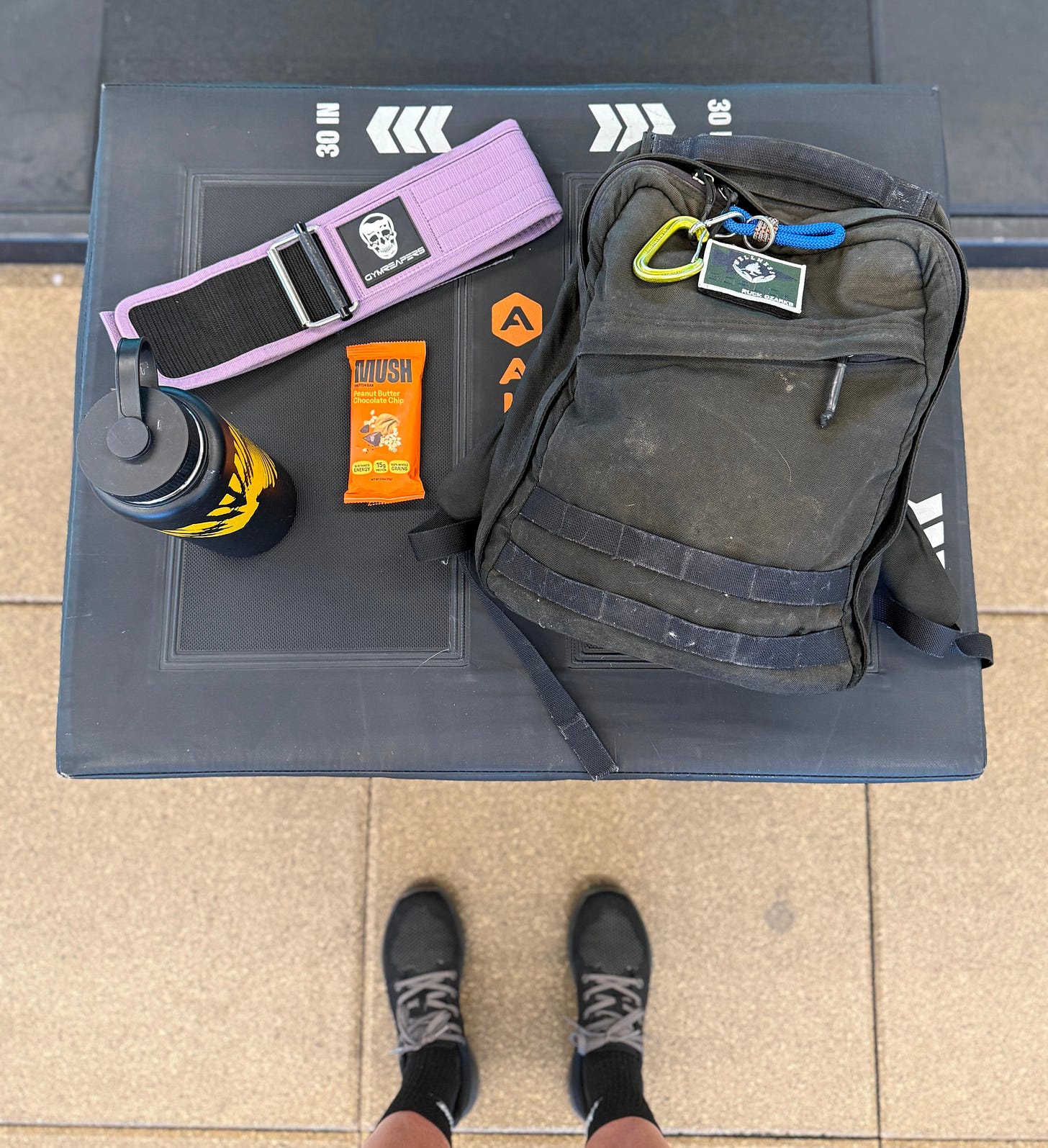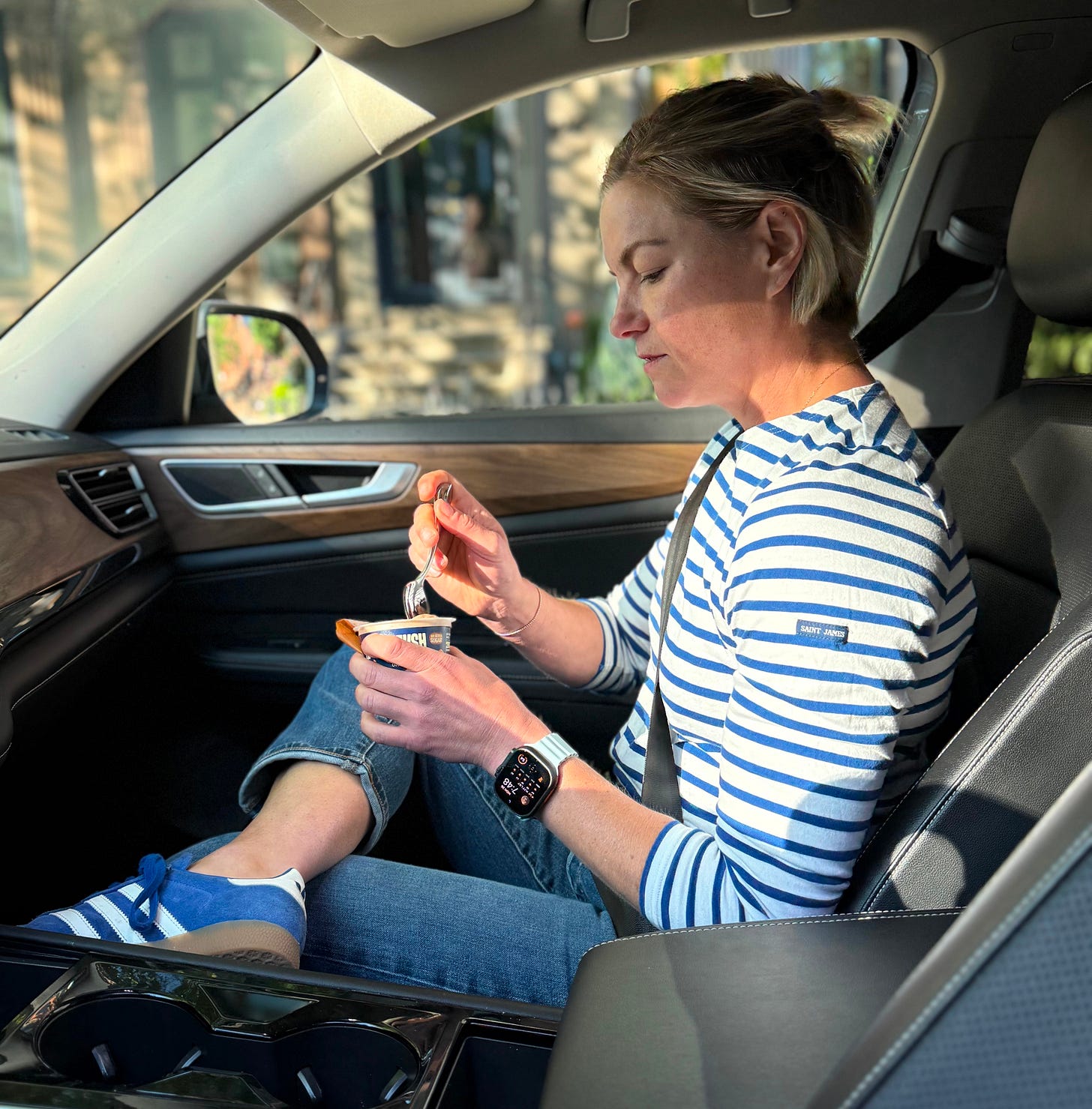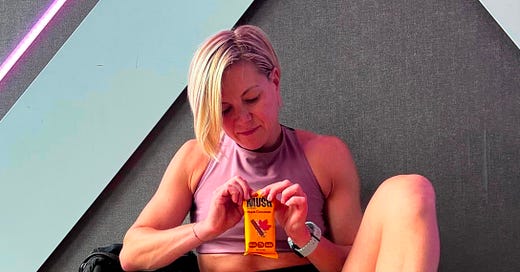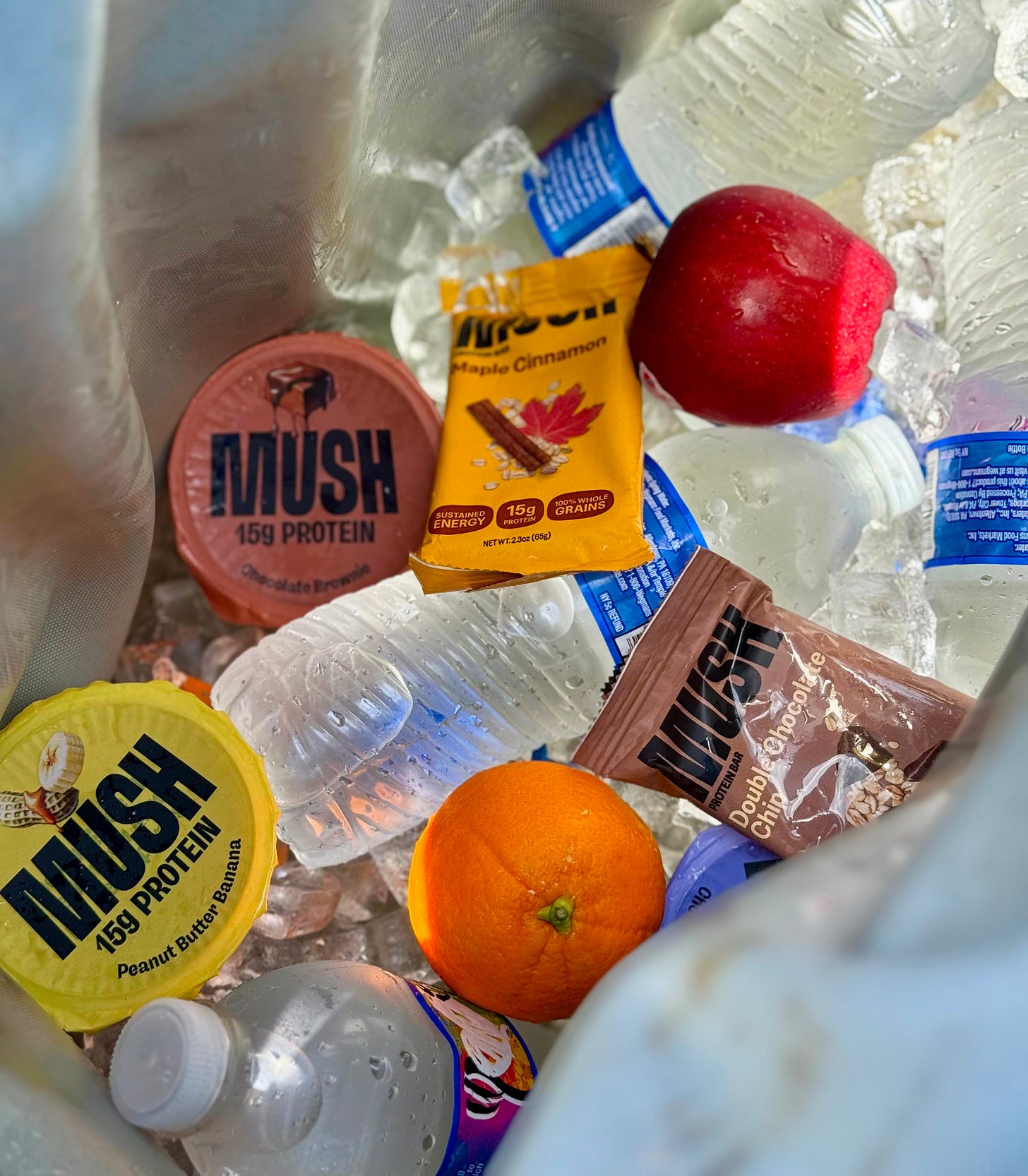Exactly How I Eat 100+ Grams Of Protein A Day
Not a hack. Not a spreadsheet. Just a mom-of-three with goals—and a protein bar in her bag.
I’m a mom of three who wakes up early to walk my dog, strength train at my local YMCA, and get my kiddos out the door to school while unloading the dishwasher and managing a household’s worth of science fairs, birthday invites, soccer and baseball games, playdates, and camp forms. I also consult for brands in the health space, moderate panels, record podcasts, film live TV segments, and write this Substack. Whew!
I want to feel strong, energized, and focused so I can show up at 100% for all of that.
That’s where protein comes in. It’s the macro that changed everything in my life.
I’ve written before about how I used to think I ate enough protein. I’d add a little salmon to my salad. A dollop of Greek yogurt here and there. But once I actually started tracking how much I was consuming in an average day a few years back? I discovered that I was only eating maybe 40–50 grams most days. Not nearly enough to support my training, recovery, energy, and mood. Especially as a woman navigating all of the hormone changes that come with midlife. (I’m 46 years old.)
Now, I aim for at least 100 grams a day. I don’t always hit it perfectly! But I’ve built habits—and a go-to protein playbook—that make that goal much more reachable, even on my busiest and most chaotic days. For anyone trying to build strength, preserve muscle, support their metabolism, and just feel better in their body, I’m sharing how I hit my daily goal.
I'm proudly partnering with MUSH on this post, because when something makes my routine stronger, I share it with you.
Why Protein Matters So Much
As we get older, our bodies become less efficient at using the protein we eat. It’s a phenomenon known as anabolic resistance—and it means we need more protein to trigger the same muscle-building and repair response that came easily in our 20s. Don’t just take my word for it: there’s a ton of research that has shown prioritizing protein in midlife women helps offset this effect and preserves lean muscle mass as we age.
Muscle doesn’t just look good. (Though I think it’s pretty rad to rock a big flex and visible abs!) It plays a key role in metabolic health, supports hormone regulation, and is linked to improved mood and cognitive function. Eating enough protein has also been linked to lower cortisol levels, better sleep, and steadier mood and emotional resilience.
Research suggests declining estrogen can reduce muscle protein synthesis efficiency, which means women in perimenopause and menopause may benefit even more from a consistent, higher-protein diet. And while this hormonal shift is unique to women, everyone experiences some degree of anabolic resistance with age.

I’ve also written about how to fuel before and after workouts, and shared that the best case scenario is for women in midlife to train in a fed state whenever possible and then to prioritize post-exercise protein within 30 minutes. That’s when our muscles are primed to absorb nutrients—and when protein does the most good.
The Case For The Fourth Meal (Or Strategic Snacks)
Here’s something I didn’t fully appreciate until I started paying attention to my own energy levels and researching this macro in earnest: spreading protein across the day is just as important as total intake. People who evenly distributed protein across four meals had greater muscle protein synthesis than those who ate the same total amount in two large doses according to a widely cited study in The Journal of Nutrition. (There are lots more like this; search PubMed.)
I aim for 25–30 grams per meal/snack (“feeding” in scientist parlance) with four daily anchors. But there is also solid research (including this study with women) that shows 15g at a time activates a significant protein synthesis response in our bodies.
Here’s a pretty typical day for me right now (I’ve been writing at dawn and doing my workout right after dropping off George at elementary school)…
Breakfast: scrambled eggs or protein smoothie plus MUSH protein oats
Post-workout: MUSH protein bar
Lunch: grilled chicken and green salad with lots of veggies
Snack: (not every day, but especially during my luteal phase) MUSH overnight oats, Greek yogurt with berries, cottage cheese with herbs on toast, a few hard-boiled eggs
Dinner: burger, chickpea pasta with beans and veggie sauce, fish and veg (Matt cooks, I’m the sous chef)
Supplements: I take EAAs and creatine every morning with a big glass of water
How I Make It Happen
My life is a colorful, wonderful blur of work and kids and, if I’m being honest, chaos. So my protein strategy is simple: make the default easy.

I stock my fridge with go-to proteins I like. I repeat meals and snacks that I enjoy. I pack snacks in my gym bag to make my post-workout refuel automatic—not something I negotiate with myself about. And I bring healthy, protein-forward options when I’m on the road…cars, planes, trains, buses. (Thirteen trips and counting this year, omg.)
Why I Keep MUSH In My Bag (and Cooler)
My first experience with MUSH’s new protein line was over Memorial Day Weekend on a roadtrip to Hershey Park for my youngest son’s soccer tournament. I drove three kids and another mom through holiday traffic, and instead of going crazy on junk food snacks at gas stations, I reached for the refrigerated peanut butter chocolate bar I’d tossed in my ruck: 15 grams of complete protein. Nothing artificial. No sugar alcohols. It actually tasted good. No weird aftertaste. Better for my energy than one of those gas station, machine coffees with french vanilla syrup (and I have been known to be tempted by those, ha).
Muffins in the hotel breakfast buffet? Nah. I borrowed a hotel spoon and enjoyed my MUSH oats out of my room’s fridge. On the sidelines all weekend, I was set because I’d tucked MUSH overnight oats and bars into my Yeti cooler alongside water bottles and fruit for the kids.
On a work trip in Jacksonville a couple of weeks ago for a women’s shoot with GORUCK, I brought my bars and oats to set. After very little sleep, a big workout with two of the brand’s female executives, and an early call time, I was at risk of crashing. No time for a meal, no blender for a smoothie. But my protein snacks saved me.
There Are A Lot Of Nutrition Bars On The Market
We are in the midst of a veritable protein boom: bars, cereals, yogurts, even chips. I love that strength, satiety, and metabolic health are having a moment. But with so many options on shelves, it’s worth pointing out that not all protein bars are created with the same nutritional integrity. Some lean on marketing buzzwords (“keto,” “low-carb”) while packing more added sugar than a doughnut. Others sneak in sugar alcohols or synthetic fibers that taste kind of gross at best, and cause bloating and digestion issues at worst. And a surprising number are calorie-dense without being nutrient-dense, meaning they don’t deliver the protein-to-calorie payoff many of us are actually looking for.
Here’s what I look for in a bar that earns a spot in my GORUCK (which is my gym bag, carry-on bag, everything bag):
Protein: At least 15g of complete protein—enough to meaningfully support muscle protein synthesis, especially for women in midlife.
Digestibility: No sugar alcohols like sorbitol or erythritol, which can cause bloating or discomfort (especially around workouts).
Added Sugar: Under 6g of added sugar—ideally from recognizable sources like dates or maple syrup, not syrups and isolates.
Ingredient Transparency: If I can’t pronounce it, or it reads like a chemistry experiment, it’s a no.
Taste: Real-food flavor. Not chalky, artificial, or ick.
That’s why I’m into MUSH’s new refrigerated protein bar. It hits the nutritional marks and tastes good. Plus, my kids like them. Which was especially helpful over MDW when George needed a boost in between games. He did not miss the chips and gummy bears.
Here’s when I eat them:
After an early morning lifting session
In an Uber between Brooklyn and the soccer field
While I’m traveling: roadtrips, train rides, airports; repeat
Before a podcast interview
When I’m under my protein goal for the day
On set when lunch is hours away and I need something solid
The Final Whistle
Protein may be having a moment right now, but its foundational role in your health is not new. This is especially true for women in midlife who want to preserve muscle, feel energetic, and stay strong. You don’t need to overhaul your diet. You just need a few high-impact habits—and foods you actually want to eat. Having a few go-to options keeps me energized for workouts, makes me more patient with my kids, and helps me show up clear and focused for work.
And it’s easier to hit your goals when your fridge and bag are stocked with things you actually want to eat. If that sounds like your vibe, give the new MUSH protein line a try, or look for their bars and overnight oats in a refrigerated aisle near you! I’m genuinely grateful to have a protein bar and overnight oats I want to pack—and that help me hit my goals without making it a big deal.
Trying to consume 100g of protein every day, too? Love that for you. Leave a comment or send me your favorite snacks and hacks.







As I try to build lean muscle and get stronger, I’m also trying to lose belly and thigh weight I’ve gained with menopause. It feels like walking a tightrope balancing calorie intake (I’m not really keeping track) with taking in enough protein. Do I just jettison the former and keep at it, and things fall into place, or do I need to be more vigilant about my caloric intake? I keep hearing different things from different people, and I’ll never ever be someone to weigh out 52 grams of banana.
Edamame beans with a dash of soy. But don't try to eat and type at the same time. It gets messy!